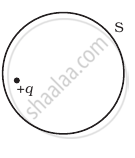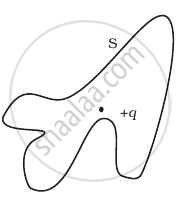Advertisements
Advertisements
प्रश्न
The Electric flux through the surface
 (i) |
 (ii) |
 (iii) |
 (iv) |
विकल्प
in Figure (iv) is the largest.
in Figure (iii) is the least.
in Figure (ii) is same as Figure (iii) but is smaller than Figure (iv)
is the same for all the figures.
उत्तर
is the same for all the figures.
Explanation:
According to Gauss’ law of electrostatics, the total electric flux out of a closed surface is equal to the charge enclosed divided by the permittivity,
i.e., `phi = (Q_(enclosed))/ε_0`
Thus, electric flux through a surface doesn’t depend on the shape, size or area of a surface but it depends on the amount of charge enclosed by the surface.
In the given figures the charge enclosed is the same that means the electric flux through all the surfaces should be the same.
APPEARS IN
संबंधित प्रश्न
State and explain Gauss’s law.
A charge ‘q’ is placed at the centre of a cube of side l. What is the electric flux passing through each face of the cube?
A thin conducting spherical shell of radius R has charge Q spread uniformly over its surface. Using Gauss’s law, derive an expression for an electric field at a point outside the shell.
State Gauss’s law for magnetism. Explain its significance.
Answer the following question.
State Gauss's law on electrostatics and drive expression for the electric field due to a long straight thin uniformly charged wire (linear charge density λ) at a point lying at a distance r from the wire.
Gaussian surface cannot pass through discrete charge because ____________.
Gauss' law helps in ______
Five charges q1, q2, q3, q4, and q5 are fixed at their positions as shown in figure. S is a Gaussian surface. The Gauss’s law is given by `oint_s E.ds = q/ε_0`
Which of the following statements is correct?
In finding the electric field using Gauss law the formula `|vec"E"| = "q"_"enc"/(epsilon_0|"A"|)` is applicable. In the formula ε0 is permittivity of free space, A is the area of Gaussian surface and qenc is charge enclosed by the Gaussian surface. This equation can be used in which of the following situation?
A charge Q is placed at the centre of a cube. The electric flux through one of its faces is ______.
